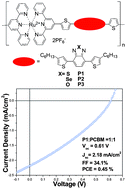Synthesis and applications of main-chain Ru(ii) metallo-polymers containing bis-terpyridyl ligands with various benzodiazole cores for solar cells†
Abstract
A series of π-conjugated bis-terpyridyl

* Corresponding authors
a
Department of Materials Science and Engineering, National Chiao Tung University,Hsinchu, Taiwan, ROC
E-mail:
linhc@cc.nctu.edu.tw
Fax: +8863-5724727
Tel: +8863-5712121 ext.55305
b Research Center for Applied Sciences, Academia Sinica, Taipei, Taiwan, ROC
c Department of Photonics, National Chiao Tung University, Hsinchu, Taiwan, ROC
A series of π-conjugated bis-terpyridyl

 Please wait while we load your content...
Something went wrong. Try again?
Please wait while we load your content...
Something went wrong. Try again?
H. Padhy, D. Sahu, I. Chiang, D. Patra, D. Kekuda, C. Chu and H. Lin, J. Mater. Chem., 2011, 21, 1196 DOI: 10.1039/C0JM02532A
To request permission to reproduce material from this article, please go to the Copyright Clearance Center request page.
If you are an author contributing to an RSC publication, you do not need to request permission provided correct acknowledgement is given.
If you are the author of this article, you do not need to request permission to reproduce figures and diagrams provided correct acknowledgement is given. If you want to reproduce the whole article in a third-party publication (excluding your thesis/dissertation for which permission is not required) please go to the Copyright Clearance Center request page.
Read more about how to correctly acknowledge RSC content.
 Fetching data from CrossRef.
Fetching data from CrossRef.
This may take some time to load.
Loading related content
